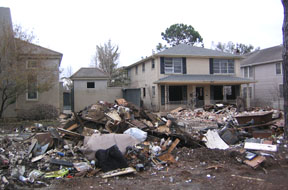 |
Office of Media Relations | |||
News | ||||
|
Katrina’s Impact
Hurricane Katrina: Who Was Hit? Who Will Return?
The First In-Depth Demographic Analysis of the Strike Zone The images were accurate: The Gulf Coast’s poor, black residents were hit hardest by Hurricane Katrina, according to findings by a Brown University sociologist. Professor John Logan’s new research is the first of its kind from the disaster zone and raises provocative questions about the future population of New Orleans. PROVIDENCE, R.I. — The Gulf Coast’s African Americans and poorest residents were disproportionately impacted by Hurricane Katrina, according to new findings from Brown University sociologist John Logan. His research, analyzing who lived in the most heavily damaged areas, is the first in-depth demographic analysis conducted in Katrina’s strike zone. It also raises serious questions about who will return to the storm-ravaged areas. The findings indicate New Orleans alone is at risk of losing more than 80 percent of its black population if people cannot return to flooded neighborhoods. 
“The suffering from the storm certainly cut across racial and class lines,” said Logan, director of Brown University’s Spatial Structures in the Social Sciences (S4) Initiative. “But the odds of living in a damaged area were clearly much greater for blacks, residents who rented their homes, and poor people. In these respects, the most socially vulnerable residents also turned out to be most exposed to Katrina.” Across the region, nearly 650,000 people lived in areas that sustained moderate to catastrophic damage. Logan’s research shows significant demographic disparities between that population and those who lived in undamaged zones. The population of the damaged areas was:
Logan’s report features extensive detail on social differences among each of the city’s 13 planning districts and 72 neighborhoods. “The analysis reveals great variation within New Orleans, but there is a general tendency for blacks and poor residents to have greater odds of being in harm’s way, because they lived in less desirable, low-lying areas,” Logan said. Logan believes the findings have implications for the future of the Gulf region, and especially for the city itself. Blacks were less likely to be homeowners and had average incomes 60 percent lower than whites. This means that it will be more difficult for them to reestablish their lives in New Orleans without assistance. In addition, damaged neighborhoods housed just half of the city’s whites but more than 80 percent of its African-American population. Decisions to prevent rebuilding in heavily flooded areas will disproportionately affect blacks simply because of where they lived. The findings are based on a combination of U.S. Census data and the Federal Emergency Management Agency’s disaster classification for each area. This report is the first fruit of a collaborative project studying Hurricane Katrina’s social and environmental impacts. In addition to Logan, the interdisciplinary team includes Phil Brown, professor of sociology; Steve Hamburg, associate professor of environmental studies; Rachel Morello-Frosch, assistant professor of environmental studies; and Jack Mustard, associate professor of geological sciences. The group received an SGER award from the National Science Foundation for the research. Subsequent analyses will use remote sensing to map patterns of damage in more detail and trace the rebuilding of neighborhoods in the region. To supplement this report, Brown University’s American Communities Project developed a Web-based map system, which allows users to identify damaged areas and sort the information by census variables. More information on the project is online at www.s4.brown.edu/katrina. A full copy of Logan’s report is available at www.s4.brown.edu/Katrina/report.pdf ###### Media Relations Home | Top of File | e-Subscribe | Brown Home Page | ||||